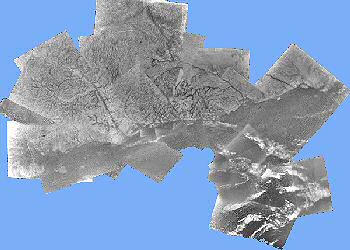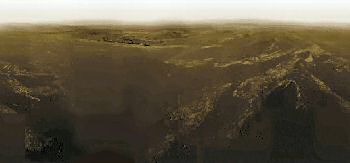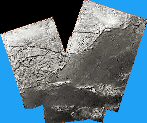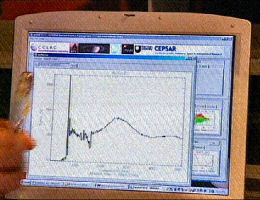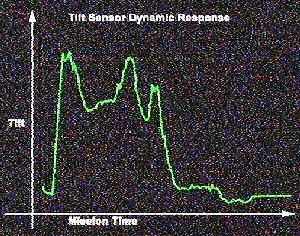On 14 January ESA's Huygens probe made an historic first ever descent to the surface of Titan, 1.2 billion kilometres from Earth and the largest of Saturn's moons. Huygens travelled to Titan as part of the joint ESA/NASA/ASI Cassini-Huygens mission. Starting at about 150 kilometres altitude, six multi-function instruments on board Huygens recorded data during the descent and on the surface. The first scientific assessments of Huygens' data were presented during a press conference at ESA head office in Paris on 21 January. New results were outlined at a press conference in Paris, France on Friday, 21 st Jan.
Liquid methane rain feeds river channels, lakes, streams, and springs on the surface of Saturn's moon Titan.
"Islands in the stream"... possible 'islands' on a dark plain
|
 |
|
|
These images from the Huygens DISR instrument show new features, such as evidence of flow around 'islands', deposits of water ice and channels which could have been created by methane springs. |
Scientists have also recovered much data from Huygens that had been thought lost due to a communications failure, that missing data could be recovered via a network of radio telescopes that listened for Huygens' signals
Huygens landed on Titan at around 1138 GMT at a leisurely speed of around 5m/s. Cassini received data from Huygens until 1250 GMT when the orbiter passed over the horizon and severed the communications link.
But the Parkes radio telescope was still receiving a signal from Huygens at 1555 GMT |
 |
|
Two new Titan features - water ice and methane springs
|
The probe’s descent was bumpier than expected in the upper atmosphere. During its descent through high-altitude haze, it rocked about 10 - 20 degrees. But below the haze layer, the probe was more stable, tilting less than 3 degrees. The reason for this seems to be that the wind changed direction at about 25 kilometres altitude.
No data from any of the nine sensors was lost. More than 474 megabits of data were received.
When Huygens touched down it experienced deceleration of about 15g in 40 milliseconds.
|
|
 |
Mosaic of river channel and ridge area on Titan
|
Image Credit: ESA |
|
" The liquid was within a few centimetres of the surface. Our feeling is that in the place we landed it must have rained not that long ago "
The pattern of rainfall on Titan may be seasonal.
Visible are short, stubby dark channels that may have been formed by 'springs' of liquid methane rather than methane 'rain' |
|
 |
|
Image Credit: ESA |
|
New, stunning evidence based on finding atmospheric argon 40 indicates that Titan has experienced volcanic activity generating not lava, as on Earth, but water ice and ammonia.
"The area we landed in is more typical of arid regions. The river beds are dry most of the time. Then after rains you have open flowing liquid. There are pools and then they dry out and the liquid methane sinks into the surface."
"We see a ridge system with a peak 100 metres tall."
There is a hint of how the hills are built:
"In another region we see a white streaky pattern, evidence of water ice being extruded by the surface." |
|
 |
|
Image Credit: ESA |
|
DISR surface images show small rounded pebbles in a dry riverbed. Spectra measurements (colour) are consistent with a composition of dirty water ice rather than silicate rocks. However, these are rock-like solid at Titan's temperatures.
Titan's soil appears to consist at least in part of precipitated deposits of the organic haze that shrouds the planet. This dark material settles out of the atmosphere. When washed off high elevations by methane rain, it concentrates at the bottom of the drainage channels and riverbeds contributing to the dark areas seen in DISR images.
|
|
 |
|
Image Credit: ESA |
|
Scientists speculate that the white streaks are a ground 'fog' of methane or ethane vapour
 click here for interactive panorama click here for interactive panorama
 click here for latest news click here for latest news
|
| |
|
Tidal Basin
? (
Titan’s orbit period of 15.95 days, and the moons position relative to Saturn would mean that the `tide` was rising.)
Titan’s orbit period of 15.95 days, and the moons position relative to Saturn would mean that the `tide` was rising.
"It looks like something has flowed at some time to make those channels. But is it something that has solidified?"
The drainage channels were either caused by falling rain or seepage of liquid hydrocarbons similar to lighter fuel or natural gas
(CH4) which had soaked into the ground. |
 |
|
|
First Data from Penetrometer as it extended 15 cm into the surface. |
Initial results show that Titan has a troposphere, At a height of 50 km up The probe measured a freezing –203°C as it passed through it, compared with a -179°C ground temperature.
One radio channel was lost so only 350 photos were taken, instead of the expected 700+.
The probe landed at a slight 20 degree tilt (Revised: 8° tilt) on to a `rock (of ice)` strewn surface that has a brittle surface crust, below which is a thicker layer with the consistency of wet sand or clay. Its composition,is mainly a mix of dirty water ice and hydrocarbon ice, resulting in a darker
soil than expected.
The atmospheric pressure is similar to earth. |
 |
|
|
Data recorded from the Greeen Bank telescope |
 |
|
|
Data from the tilt sensor. |
|
| The ratio of carbon isotopes C12 and C13 in Titan's atmosphere, measured by the Huygen probe's Gas Chromatograph and Mass Spectrometer (GCMS) instrument, indicates that methane is being replenished on the freezing world. Previous evidence suggested that lighter isotopes of oxygen and nitrogen would have escaped from the atmosphere into space at a greater rate than the heavier isotopes. This would change the isotopic ratio of the elements - a process called fractionation. But the atmospheric carbon isotopes do not show the same trait, implying the gas is being replenished. Continuing geological activity beneath the surface is thought to be the most likely source. |
A sound file generated from the communication between the Cassini spacecraft and the Huygens probe has been released by ESA. This was converted to an audio file to show the descent profile indicating how the Huygens probe moved through the atmosphere of Titan.
 To Listen: To Listen:
|
As the Huygens probe plunged through Titan’s atmosphere, it sent back scientific data. It landed on Titan at around 1138 and transmitted a signal until at least 1555 GMT.
Scientists will comb the data sent back for the chemical signature of life in a bid to identify the moon's source of methane.
Methane is constantly destroyed by UV light so there must be a source within Titan to replenish the atmosphere.
Life could be a possible source of this hydrocarbon along with geological processes.
Titan is too cold for surface biology, but microbes could survive deep within Titan.
Methane can also be released from a trapped form called clathrate and can be produced by a geological process called "serpentisation".
Neither of these involves biology.
Dominated by nitrogen, methane and other organic molecules, Titan resembles a deep-frozen version of Earth 4.6 billion years ago.
Liquid methane rains down on Titan into river channels carved between hills of water ice. Reservoirs of this hydrocarbon probably lie on or just below the surface.
But UV light would destroy all the methane on Titan within 10 million years if it were not being constantly renewed.
"We cannot say there is absolutely no chance for life. Models of Titan's interior show there should be an ocean about 100km deep at around 300km below the surface."
If the models are correct, this ocean would be composed mostly of liquid water with about 15% ammonia at a temperature of about -80°C.
"We have liquid water, organics not so far away; we have everything on Titan to make life.”
If methane-producing microbes had colonised this habitable zone, scientists might detect its chemical signature by looking at the relationship of two forms (or isotopes) of the element carbon - C12 and C13.
Living cells preferentially incorporate C12. So compounds produced by living things should be depleted of "heavier" isotopes such as C13, and have a high C12/C13 ratio.
Scientists should be able to measure this ratio in data sent back by the Gas Chromatograph Mass Spectrometer (GCMS) instrument on Huygens.
"The GCMS can directly detect the C12/C13 carbon ratio. We haven't done that yet, but we're working on it".
"It's one factor we can take into account to figure out how methane is getting replenished."
However, scientists favour the geological process of serpentisation as a more likely source of the moon's methane.
In serpentisation, geothermal activity generates methane through the oxidation of metals such as iron, chromium and magnesium which could be contained in crustal rocks below Titan's surface.
Another possibility is that methane molecules are trapped in a water-ice matrix called clathrate (or methane hydrate). |
 Unveiling Titan: February 2005 Unveiling Titan: February 2005
We have seen the surface of Titan, one of the most mysterious bodies in the Solar System. Patrick Moore talks to the project's lead scientist, Professor John Zarnecki, about the first results from the Huygens probe. |
 Lord of the Rings: January 2005 Lord of the Rings: January 2005
Patrick Moore discusses the spacecraft Cassini, which has been at Saturn for six months, and Cassini's probe Huygens, which was sent to Titan. |
|

All images credits go to ESA and JPL and University of Arizona |




